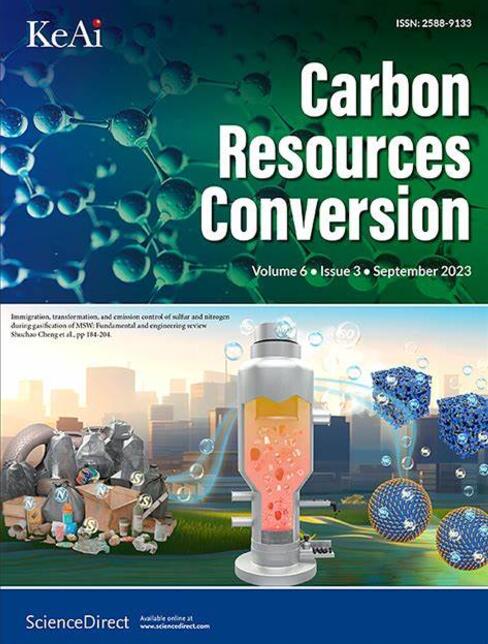在最佳温度下用共培养系统从甜高粱茎汁中高效生产丁醇:来自氧化还原电位监测和中试规模验证的见解
IF 7.5
3区 环境科学与生态学
Q2 ENERGY & FUELS
引用次数: 0
摘要
采用两阶段共培养法进行丙酮-丁醇-乙醇(ABE)发酵。一种专性好氧细菌Arthrobacter sp.首先在30°C下培养6小时以创造厌氧条件。随后,接种贝氏梭菌TISTR 1461, 37℃发酵。为了确定适合这两种微生物的中间温度,在30,34和37°C下检查了它们的生长。C. beijerinckii在37℃的特定生长率最高,而Arthrobacter sp.在所有测试温度下均表现出相似的生长速度。以无氧氮(OFN)气冲为对照处理,贝氏C. beijerinckii在不同温度下合成培养基(P2培养基)生产丁醇的结果表明,37℃发酵时丁醇浓度最高(PB, 9.98 g/L)。因此,选择37°C从甜高粱茎汁(SSJ)中通过这两种微生物在1升螺旋盖瓶中共同培养生产丁醇。与对照处理相比,共培养体系可获得更高的PB (11.38 g/L)、产量(YB/S, 0.37 g/g)和生产力(QB, 0.24 g/L·h)。通过在2l搅拌槽生物反应器(STR)中监测ABE发酵过程中的氧化还原电位(ORP),进一步证实了这些结果。此外,当在30-L STR中扩大37°C共培养发酵时,PB, YB/S和QB值与在2-L STR中获得的值相当。因此,节杆菌sp.和C. beijerinckii TISTR 1461在37°C下共培养发酵是一种有前景的大规模丁醇生产方法。本文章由计算机程序翻译,如有差异,请以英文原文为准。

Efficient butanol production from sweet sorghum stem juice by a co-culture system at an optimum temperature: Insights from oxidation-reduction potential monitoring and pilot scale validation
A two-stage co-culture approach was employed in an acetone-butanol-ethanol (ABE) fermentation. An obligate aerobic bacterium, Arthrobacter sp., was first grown for 6 h at 30 °C to create anaerobic conditions. Subsequently, Clostridium beijerinckii TISTR 1461 was inoculated and a fermentation was performed at 37 °C. To identify an intermediate temperature suitable for both microorganisms, their growth was examined at 30, 34, and 37 °C. C. beijerinckii exhibited the highest specific growth rate at 37 °C, while Arthrobacter sp. displayed similar growth rates at all tested temperatures. Butanol production from a synthetic medium (P2 medium) by C. beijerinckii at different temperatures using oxygen-free nitrogen (OFN) gas flushing as a control treatment revealed that fermentation at 37 °C gave the highest butanol concentration (PB, 9.98 g/L). Consequently, 37 °C was chosen for butanol production from sweet sorghum stem juice (SSJ) by co-culture of these two microorganisms in 1-L screw–capped bottles. Compared to the control treatment, higher PB (11.38 g/L), yield (YB/S, 0.37 g/g) and productivity (QB, 0.24 g/L·h) were achieved using the co-culture system. These results were further confirmed by monitoring the oxidation–reduction potential (ORP) during ABE fermentation in a 2-L stirred-tank bioreactor (STR). Moreover, when the co-culture fermentation at 37 °C was scaled up in a 30-L STR, the PB, YB/S and QB values were comparable to those obtained in the 2-L STR. Therefore, co-culture fermentation of Arthrobacter sp. and C. beijerinckii TISTR 1461 at 37 °C represents a promising method for large-scale butanol production.
求助全文
通过发布文献求助,成功后即可免费获取论文全文。
去求助
来源期刊

Carbon Resources Conversion
Materials Science-Materials Science (miscellaneous)
CiteScore
9.90
自引率
11.70%
发文量
36
审稿时长
10 weeks
期刊介绍:
Carbon Resources Conversion (CRC) publishes fundamental studies and industrial developments regarding relevant technologies aiming for the clean, efficient, value-added, and low-carbon utilization of carbon-containing resources as fuel for energy and as feedstock for materials or chemicals from, for example, fossil fuels, biomass, syngas, CO2, hydrocarbons, and organic wastes via physical, thermal, chemical, biological, and other technical methods. CRC also publishes scientific and engineering studies on resource characterization and pretreatment, carbon material innovation and production, clean technologies related to carbon resource conversion and utilization, and various process-supporting technologies, including on-line or off-line measurement and monitoring, modeling, simulations focused on safe and efficient process operation and control, and process and equipment optimization.
 求助内容:
求助内容: 应助结果提醒方式:
应助结果提醒方式:


